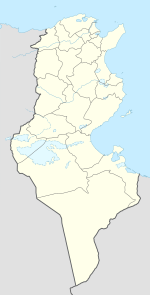Test tour
Coordinates: 36 ° 33 ' N , 9 ° 27' E
Testour ( Arabic تستور, DMG Tastūr ) is a city in northern Tunisia with around 23,500 inhabitants (2004). It is located about 77 km west of Tunis on the eastern banks of the Medjerda . Testour was founded in the 16th century by expelled Spanish Moors over the remains of the ancient town of Tichilla .
Roman turbine mill in Testour
One of the achievements of the Romans was the construction of turbine mills in the 3rd to 4th centuries . Muscle power has been replaced by water power and so you could probably grind grain with these turbine mills all year round. Each of the mills had three grinders, which were directly driven by three turbines.
Friedrich Rakob writes about this in the Antiken Welt , issue 4/1993:
“Since its discovery and reconstruction by J. and G. Röder, the Roman turbine mill in the rubble area of the Roman Medjerda Bridge in Chemtou has remained unique. In the first volume of the German-Tunisian excavation publication, which is due to appear in October 1993, G. Röder has the essential The difference between this system and other ancient mills is shown in detail. The hope, formulated in the final sentence of their investigation, that further examples of this unusual technical innovation would appear in the future, has been confirmed sooner than was expected. "
In the city of Testour, founded by expelled Spanish Moors in the 16th century AD over the remains of the ancient town of Tichilla, which is 81 km west of Tunis on the right bank of the Medjerda and is crossed by the road to Dougga, is below the inhabitants On the steep slope, a ruin, partially buried and difficult to access, is familiar to the bank, which was considered to be a building of Andalusian architecture for the milling of wool. The ruins remained unknown to archaeological research for a long time. It was not until the spring of 1993 that Uwe Bigalke , the managing director of a German company based in Testour, discovered that the plant can be fully compared with the turbine mill in Chemtou / Simitthus, which is also on the banks of the Medjerda . The mill building corresponds exactly to the plant in Chemtou in terms of its dimensions, construction technology and details. As there, the ashlar structure made of spoil was erected over a heavy Caementicium base made of large pebbles. A water inlet to the three channels broke away in the northern canal in the floods of 1979, its northern wall is now tilted horizontally in the river. In contrast to Chemtou, the second channel still has its original plate cover, the third is buried on the steep bank. But the remains of the rising east wall of the mill building show the original size of the building. The grooves for the support supports and the remains of the round turbine shafts, which were clad with bricks above the limestone wheel arches, are clearly visible. Since the dimensions and details are identical to the mill in Chemtou, the plant was probably built at the same time as the one in Simitthus. While the rubble situation of the Roman bridge was able to accumulate the Medjerda water there, in Testour a storage canal seems to have been created after a clearly recognizable cuboid position in the shallow water after upstream. The study of this new, significant example of late antique technology was carried out in 2007. After further inspections, the researchers came to the conclusion that it was not a storage canal, but probably a second system. According to their assumptions, the plant was either built parallel to the other plant, or it was a predecessor that could not withstand the back pressure in the river loop.
Personalities
- Driss Guiga (* 1924), politician

